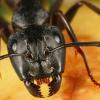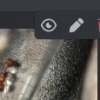This is going to be a detailed description of 2 different Camponotus colonies that I have; 1 Camponotus subbarbatus and 1 Camponotus pennsylvanicus.
This is going to require some context. There are actually 4 colonies in question here, 2 of each species. The 2 pennsylvanicus colonies had 1 worker and 9 workers, and the subbarbatus had 4 and 200 workers each.
All of these colonies originate from the same area. The largest colony was actually wild-caught on accident, I brought home a piece of wood from the forest for use as an accent piece in an outworld of mine and it just happened to have the colony living inside of it. The other, smaller colonies were all from queens collected in the same forest.
The location, this forest in question, is quite small, with an area of maybe an acre, and around it is cornfields and an abandoned barn. The ant diversity in this area is phenomenal, with the dominant species in the forest being C. subbarbatus and the dominant in the barn being C. pennsylvanicus. There are also large populations of Lasius claviger, other Lasius spp., Aphaenogaster spp., Tapinoma sessile, and others.
The first incident was around a week ago. My 9 worker pennsylvanicus colony's queen died in hibernation. and yes, died, not just deep hibernation. I was saddened by this, but I knew I had my 1 worker colony. I decided to do the unthinkable and basically just dump the queen and her worker into the test tube with the 9 workers. This was after removing the dead queen. The worst that happened was the queen bared her mandibles at the new workers, but there were no strikes between workers or the queen. After around 5 minutes, all the ants had settled, and after another 20 they were seen cleaning each other. I have since placed this colony back into hibernation.
Now, for the subbarbatus. My large colony of 200 workers I discovered to presumably have no fertile queen, only 3 alate queens. I assume it was likely a satellite nest from a larger colony. I also have a 4 worker colony that I had brood boosted with the 200 worker colony's larvae, since they have no queen. My plans for the large colony is to simply release them in hopes that their alates will be able to fly. Well, my 4 worker colony lost a worker in hibernation, and I was scared for the colony having so much brood to care for with only 3 workers. I remembered what had happened with my pennsylvanicus colony, and decided to try it again. I grabbed 6 workers from the larger colony, 5 minors and 1 major, and slowly introduced them, each one being accepted by the small colony just like the last. Now the colony has more workers to care for all of their brood (although I want the colony to stay this size instead of getting even more workers).






















